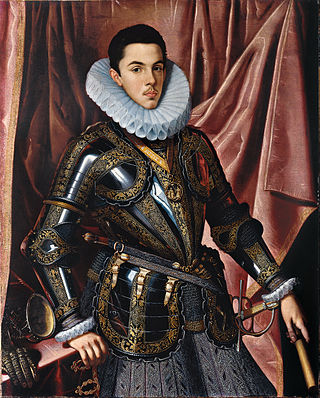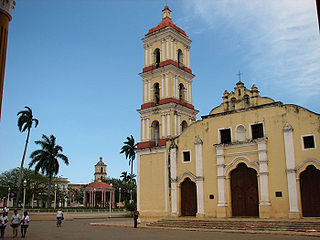Gallery
- John William Baker Palace Sketch, Trinidad, Cuba
- Photograph of a painting of John William Baker.
- Photograph of an alleged painting of Josefa Eufemio Barcelo y Villa Muñoz Valdespino, John William Baker's second wife.
John William Baker (March 10, 1781 - March 16, 1860), was an American merchant seaman who moved to Cuba and became a Spanish citizen.
He was the son of Jacob Baker, a Philadelphia, Pennsylvania merchant, and his wife, Hannah Smith. He moved to Trinidad, Cuba in 1805. and became wealthy through many businesses, including through landholdings, the slave trade and sugar plantations. He became a naturalized Spanish citizen in 1819, and changed his name to Juan Guillermo Béquer. He was later honored by Queen Isabel II of Spain with the honors of Caballero Gran Cruz de la Orden Americana de Isabel la Catolica, Gentilhombre de Camara con Estrada, Gran Cruz de Carlos III, Del Habito de Santiago, and a final title was pending prior to his death, which he consequently failed to receive as a result - Marques de San Juan de Piedras Albas.
He built himself a mansion in Trinidad. Legend says that he was so wealthy that when he tried to lay a mosaic of doubloons in the floor of the dining room, authorities pointed out it would be improper to walk on the Spanish Coat of Arms, so he inlaid them in the floor on their edges. [1]

Havana is the capital and largest city of Cuba. The heart of the La Habana Province, Havana is the country's main port and commercial center. The city has a population of 2.3 million inhabitants, and it spans a total of 728.26 km2 (281.18 sq mi)for the Capital City side and 8,475.57 km² for the Metropolitan zone – making it the largest city by area, the most populous city, and the Second largest metropolitan area in the Caribbean region.

Antonio José de Sucre y Alcalá, known as the "Gran Mariscal de Ayacucho", was a Venezuelan general and politician who served as the president of Bolivia from 1825 to 1828. A close friend and associate of Simón Bolívar, he was one of the primary leaders of South America's struggle for independence from the Spanish Empire.

A caudillo is a type of personalist leader wielding military and political power. There is no precise English translation of caudillo, though it is often used interchangeably with "warlord" and "strongman". The term is historically associated with Spain, and with Hispanic America after virtually all of the region won independence in the early nineteenth century.

Veracruz, also known as Heroica Veracruz, is a major port city and municipal seat for the surrounding municipality of Veracruz on the Gulf of Mexico and the most populous city in the Mexican state of Veracruz. The city is located along the coast in the central part of the state, 90 km (56 mi) southeast of the state capital Xalapa.

Juan Luna de San Pedro y Novicio Ancheta was a Filipino painter, sculptor and a political activist of the Philippine Revolution during the late 19th century. He became one of the first recognized Philippine artists.

The Royal Palace of Aranjuez is one of the official residences of the Spanish royal family. It is located in the town of Aranjuez (Madrid), Spain. Established in the 16th century as a royal hunting lodge, the palace was built by order of Philip II. Under his reign it became one of four seasonal seats of the court along Rascafría, El Escorial and the Royal Alcázar of Madrid. The royal estate comprises a set of landscaped and ornate gardens and woodlands that house an extensive botanical collection.

Alonso Sánchez Coello was an Iberian portrait painter of the Spanish and Portuguese Renaissance. He is mainly known for his portrait paintings executed in a style which combines the objectivity of the Flemish tradition with the sensuality of Venetian painting. He was court painter to Philip II.

Antoine, Duke of Montpensier, was a member of the French royal family in the House of Orléans. He was the youngest son of King Louis Philippe of France and his wife Maria Amelia Teresa of the Two Sicilies. He was styled as the Duke of Montpensier. He was born on 31 July 1824 at the château de Neuilly and died 4 February 1890 at Sanlúcar de Barrameda, Spain.

Juan Pantoja de La Cruz was a Spanish painter, one of the best representatives of the Spanish school of court painters. He worked for Philip II and Philip III. The Museo del Prado contains examples of his severe portraiture style.

Remedios, also known as San Juan de los Remedios, is a city and municipality located 3 miles (4.8 km) from the northern coast of Cuba, in the center of the island. It is the oldest Spanish settlement in the former Las Villas province. It is now part of the province of Villa Clara.

The Castillo de la Real Fuerza is a bastion fort on the western side of the harbour in Havana, Cuba, set back from the entrance, and bordering the Plaza de Armas. Originally built to defend against attack by pirates, it suffered from a poor location; it was too far inside the bay. The fort is considered to be the oldest stone fort in the Americas, and was listed in 1982 as part of the UNESCO World Heritage Site of "Old Havana and its Fortifications".

Fortunata y Jacinta, was written by Benito Pérez Galdós in 1887 and published in the same year. It is, together with Leopoldo Alas y Ureña's La Regenta, one of the most popular and representative novels of Spanish literary realism. Born in Las Palmas de Gran Canaria, Canary Islands, the author went to Madrid, the capital, to study law at age 18. There he would create a literary world that was present in almost all his writings. The novel was a sensation upon its release because of its scathing critique of the Spanish middle class, and for its frank sexuality. While criticized by political and religious leaders, it was praised by peers of Galdós for its realistic depiction of life amongst all classes in 19th century Madrid.

La Bulaqueña, literally "the woman from Bulacan" or "the Bulacan woman", also sometimes referred to as Una Bulaqueña, is the Spanish title of an 1895 painting by Filipino painter and revolutionary activist Juan Novicio Luna. Bulacan is a province in the Philippines in Luzon island and its residents are called Bulaqueños, also spelled as Bulakenyos in the Filipino language. It is a "serene portrait", of a Filipino woman wearing a María Clara gown, a traditional Filipino dress that is composed of four pieces, namely the camisa, the saya, the pañuelo, and the tapis. The name of the dress is an eponym to María Clara, the mestiza heroine of Filipino hero José Rizal's novel Noli Me Tangere. The woman's clothing in the painting is the reason why the masterpiece is alternately referred to as María Clara. It is one of the few canvases done by Luna illustrating Filipino culture. The painting is displayed at the National Museum of Fine Arts.
José María Coppinger was a Spanish soldier who served in the infantry of the Royal Spanish Army (Ejército de Tierra) and governed East Florida (1816–1821) and several areas in Cuba including Pinar Del Río, Bayamo, the Cuatro Villas and Trinidad at various times between 1801 and 1834. He was also a member of the Royal and Military Order of Saint Ferdinand and San Hermenegildo.

The Black Paintings is the name given to a group of 14 paintings by Francisco Goya from the later years of his life, likely between 1819 and 1823. They portray intense, haunting themes, reflective of both his fear of insanity and his bleak outlook on humanity. In 1819, at the age of 72, Goya moved into a two-story house outside Madrid that was called Quinta del Sordo. Although the house had been named after the previous owner, who was deaf, Goya too was nearly deaf at the time as a result of an unknown illness he had suffered when he was 46. The paintings originally were painted as murals on the walls of the house, later being "hacked off" the walls and attached to canvas by owner Baron Frédéric Émile d'Erlanger. They are now in the Museo del Prado in Madrid.

Amaro Rodríguez-Felipe y Tejera Machado, better known as Amaro Pargo, was a famous Spanish corsair. He was one of the most renowned corsairs in Spain of the Golden Age of Piracy.

Abelardo Rodríguez Urdaneta was a Dominican sculptor, photographer, painter and educator. A prolific artist, he was one of the first successful multidisciplinary artists of the modern art era in the Dominican Republic and considered to be one of the forerunners of Dominican sculpture, photography, and painting. His creative work consists of a large number of portraits, busts, statues, monuments and pictorial paintings in which he collected important moments in the country’s history that reflected the lives of social leaders, merchants, and families of the time.
Francisco Fellove Valdés, also known as El Gran Fellove, was a Cuban songwriter and singer. A prolific composer of the feeling generation, he is well known for his particular style of scat singing known as chua chua. He is the author of the famous guaracha-pregón "Mango mangüé", recorded by Machito and Celia Cruz among others. He was the cousin of conga drummer Carlos "Patato" Valdés.

Theodore Dietrich Garbade was a merchant and banker, he was President of the Union of Manufacturers of Cigars of Cuba.

Elizabeth Murray, born Elizabeth Heaphy, was a British watercolourist. She primarily painted portraits and landscapes of the Canary Islands, where she lived for ten years. She was a member of the Royal Institute of Painters in Water Colours, and in 1857 was one of the founders of the Society of Female Artists in London, serving on its first committee.